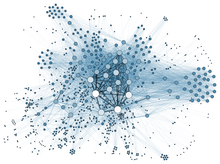Network theory
study of graphs as a representation of relations between discrete objects
Network theory is the study of graphs as a representation of either symmetric relations or, more generally, of asymmetric relations between discrete objects. Network theory is a part of graph theory: a network can be defined as a graph in which nodes and/or edges have attributes (e.g. names). It has applications in many disciplines including statistical physics, particle physics, computer science, electrical engineering, biology,[1] economics, finance, operations research, climatology and sociology.

| This science article is a stub. You can help out with Wikiquote by expanding it! |
Quotes
edit- Reports of the death of reductionism are greatly exaggerated. It is so ingrained in our thinking that if one day some magical force should make us all forget it, we would promptly have to reinvent it. The real worry is not with reductionism, which, as a paradigm and tool, is rather useful. It is necessary, but no longer sufficient. But, weighing up better ideas, it became a burden.
- Albert-László Barabási, "The network takeover", Nature Physics (Jan., 2012)
- There is a multilayering of global networks in the key strategic activities that structure and destructure the planet. When these multilayered networks overlap in some node, when there is a node that belongs to different networks, two major consequences follow. First, economies of synergy between these different networks take place in that node: between financial markets and media businesses; or between academic research and technology development and innovation; between politics and media.
- Manuel Castells (1996) The Rise of the Network Society: The Information Age: Economy, Society, and Culture Volume I
- If you peruse the table of contents of a textbook on organizational theory or search the web for courses in organizational sociology, you cannot help but notice how many of the key contributors to the field spent time at Stanford between 1970 and 2000, as faculty members, post-docs, or graduate students... Of the five most influential macro-organizational paradigms in play today — institutional theory, network theory, organizational culture, population ecology, and resource dependence theory (in alphabetical order) – Stanford served as an important pillar, if not the entire foundation, for all but network theory. By the 1990s, it became an important site for network theory as well.
- Frank Dobbin, Claudia Bird Schoonhoven eds. (2010) Stanford's Organization Theory Renaissance, 1970-2000, p. xvii
- Sociologists and anthropologists have long been concerned with how individuals are linked to one another and how these bonds of affiliation serve as both a lubricant for getting things done and a glue that provides order and meaning to social life. The attention to networks of association, which began in earnest in the 1970s, provided welcome texture and dynamism to portraits of social life. This work stood in stark contrast to the reigning approaches in the social sciences. In contrast to deterministic cultural (oversocialized) accounts, network analysis afforded room for human agency, and in contrast to individualist, atomized (undersocialized) approaches, networks emphasized structure and constraint (Granovetter, 1985). Network studies offered a middle ground, a third way, even if no one was quite sure whether networks were a metaphor, a method, or a theory (Barnes 1979). But the sociologists and anthropologists who initially studied networks did not pay sustained attention to economic activity, although some industrial sociologists (Roy, 1954; Dalton, 1959) had long stressed the role of informal networks as an antidote to formal organization practices and structures.
- Walter W. Powell and Laurel Smith-Doerr. "Networks and economic life." The handbook of economic sociology. (1994). p. 368-380; introduction.
- The same dynamics that keep us safe in a pack, herd or society, and comfortable in our family, friends or neighbours also serves as a way for pathogenic transmissions. The warmth of a human dwelling or the immense complexity of a bee hive is also an opportunity for a pathogen to tap into a susceptible population. Network interdiction is a comprehensive name for algorithms intended to disrupt such connections.
- Chris von Csefalvay, "Spatial dynamics of epidemics: Epidemics in discrete and continuous space". Computational Modeling of Infectious Disease. (2023). p. 257–303.